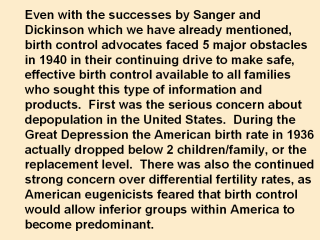| front |1 |2 |3 |4 |5 |6 |7 |8 |9 |10 |11 |12 |13 |14 |15 |16 |17 |18 |19 |20 |21 |22 |23 |24 |25 |26 |27 |28 |29 |30 |31 |32 |review |
 |
Secondly
there was the continued strong Catholic official resistance to any form of
birth control besides the rhythm method. A third anti-birth control factor was the public and professional debates concerning the morality issues involved with birth control. Fourthly, the low level of health care available to the urban and rural poor populace made birth control very difficult to achieve. For example, even after the USPS in 1942 permitted federal funds to be used for birth control activities, only 15 states by 1963 had opted to follow this path. Finally, and perhaps most importantly, was the fact that there still was not a safe, effective, easy-to-use method of contraception for those seeking birth control services. There had not been a major breakthrough in contraceptive technology since the middle of the 19th century, and the most effective contraceptive techniques still required women to see a physician i.e.: vaginal diaphragm. |